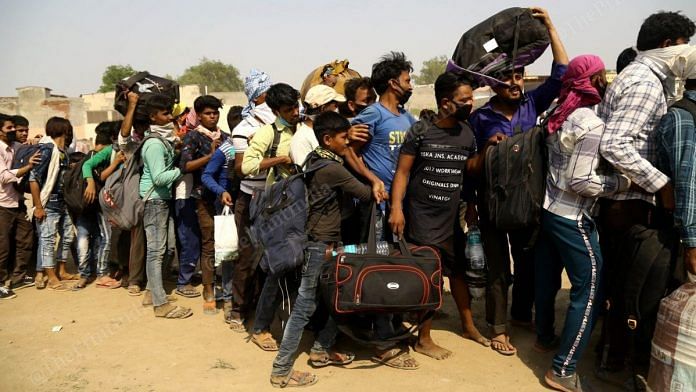
Mainstream papers focus on day 1 of phase four of the nationwide lockdown and the ease in restrictions in the national capital.
India crossing the 1,00,000 mark in Covid-19 cases has also made it to front pages, but so has the low mortality rate in the country.
Pink papers focus on the economic package introduced by the Modi government and how it is not enough to revive the economy.
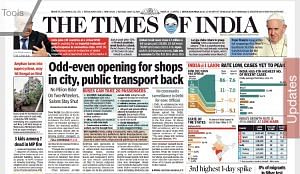 Focusing on the easing of restrictions in phase four of the lockdown for Delhi, The Times of India’s lead (‘Odd-even opening for shops in city, public transport back’) notes that coronavirus is not going anywhere, “Kejriwal said people will have to learn to live with it till a vaccine was developed.” It adds that the Delhi government has also allowed the “opening of markets, private offices and industrial estates…”
Focusing on the easing of restrictions in phase four of the lockdown for Delhi, The Times of India’s lead (‘Odd-even opening for shops in city, public transport back’) notes that coronavirus is not going anywhere, “Kejriwal said people will have to learn to live with it till a vaccine was developed.” It adds that the Delhi government has also allowed the “opening of markets, private offices and industrial estates…”
Reporting on ‘Chaos & traffic jams at capital borders on Day 1 of Lockdown 4.0’, TOI states “Delhi traffic officers said office-goers had crowded the pickets as UP cops insisted on travel passes issued by the Noida DM.”
Another report compares the response to the Covid-19 in Kerala, West Bengal and other states (‘124 recoveries for every Covid death in Kerala, just 4 in Bengal’), noting how “Tamil Nadu is among the best performers by this yardstick with 53 recoveries per death and Delhi’s 28 recoveries per death puts it well above the national average but in the middling category.”
On the eastern border front, ‘India & China deploy additional troops, fortify more Ladakh areas’. The report notes how these changes came after “heightened tensions following a violent clash between rival troops in the Pangong Tso sector on May 5-6”.
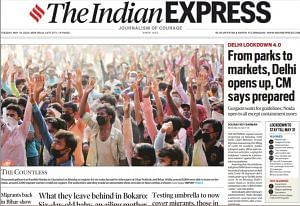 As the migrant workers’ crisis continues, The Indian Express carries a photograph of Ghaziabad migrants waiting to board trains — with the caption “THE COUNTLESS” — that covers almost the entire page above the fold –and says it all.
As the migrant workers’ crisis continues, The Indian Express carries a photograph of Ghaziabad migrants waiting to board trains — with the caption “THE COUNTLESS” — that covers almost the entire page above the fold –and says it all.
A brief report ‘Testing umbrella to now cover migrants, those in hospitals with symptoms’ highlights some crucial news from ICMR — the testing protocol will now also include symptomatic “returnees and migrants”, “hospitalised patients” and “frontline workers”.
In a shocking report, Maharashtra Housing Minister Jitendra Awhad, who just recovered from Covid-19, has downplayed the virus, even though the headline of the story is certainly alarming — ‘Was given 30% chance of survival, don’t fear virus: Minister Awhad. He said there is “unnecessary panic on social media” regarding the infection and called it “a seasonal flu” and that people shouldn’t fear it.
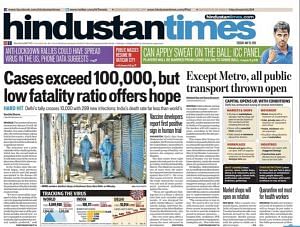 Hindustan Times is hopeful in its lead even as the number of coronavirus cases in India crosses the dreaded 1 lakh mark — ‘Cases exceed 100,000, but low fatality ratio offers hope’.
Hindustan Times is hopeful in its lead even as the number of coronavirus cases in India crosses the dreaded 1 lakh mark — ‘Cases exceed 100,000, but low fatality ratio offers hope’.
According to the report, “The trend indicates the situation may be less serious than the global scenario, where the proportion of deaths is double what has been seen in the country on an average.” The mortality rate in India stands at 3.09 per cent at present.
The migrant crisis also finds space on HT’s front page, like Express. ‘Chaos in Gzb as migrants queue up in thousands for train passes’ details how “10,000 migrant workers from Delhi and other parts of the national capital region (NCR) gathered at the Ramlila Maidan in Ghaziabad on Monday to obtain passes for six Shramik Special trains.”
Meanwhile, after a long reprieve, students must resume preparing for the board exams as ‘CBSE releases date sheet for Class 10, 12 exams from July 1’. The precautions taken include students carrying “ their own hand sanitisers in transparent bottles. They will cover their nose and mouth with (a) mask or cloth.”
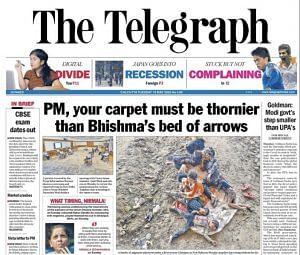 The Telegraph chooses a literary metaphor for its lead headline, invoking the epic Mahabharata.
The Telegraph chooses a literary metaphor for its lead headline, invoking the epic Mahabharata.
The report ‘PM, your carpet must be thornier than Bhishma’s bed of arrows’ is accompanied with a gut-wrenching image of a “family of migrants resting under a flyover near Ghazipur in New Delhi on Monday as police have stopped them for the past two days.”
The report is juxtaposed with an image of Prime Minister Narendra Modi in a meeting with the Cabinet, reviewing Covid-19 measures, while maintaining social distancing.
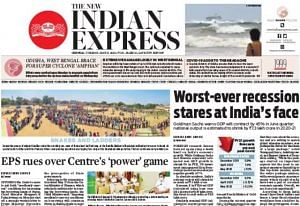 The “death knell” is about to be rung on India’s economic growth, reports The New Indian Express. In ‘Worst-ever recession stares at India’s face’, it reports that “Goldman Sachs and Nomura separately estimated real GDP growth to shrink 5 per cent in FY21” while US firm Bernstein foresees “an even sharper negative growth of 7 per cent”.
The “death knell” is about to be rung on India’s economic growth, reports The New Indian Express. In ‘Worst-ever recession stares at India’s face’, it reports that “Goldman Sachs and Nomura separately estimated real GDP growth to shrink 5 per cent in FY21” while US firm Bernstein foresees “an even sharper negative growth of 7 per cent”.
The paper predicts that if the negative growth forecasts prevail, “India will see the harshest recessions it has ever experienced” and as for the recent Atma Nirbhar package? Goldman Sachs doubts it will have “any immediate impact on the economy”, adds the report.
NIE, like HT, mentions the low mortality rate in India but notes that it has thrown up an “interesting puzzle”
In ‘LOW FATALITY RATE THROWS UP AN INTERESTING PUZZLE’, the paper notes a more astonishing trend: The range of fatality rate across states. It writes, “West Bengal with 2,677 confirmed Covid cases — at number eight in terms of case load — has nearly 9% death rate or three times the national average while Tamil Nadu, the third worst-hit state, has this figure at 0.7 — among the lowest in India. The paper says this is a “phenomenon that has not been fully explained so far”.
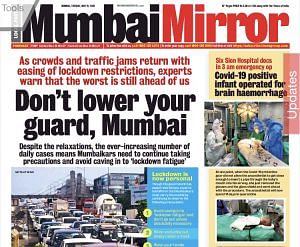 Mumbai Mirror leads with a warning for the city ‘As crowds and traffic jams return with easing of lockdown restrictions, experts warn that the worst is still ahead of us’. The report notes, “Despite the relaxations, the ever-increasing number of daily cases means Mumbaikars need to continue taking precautions and avoid caving in to ‘lockdown fatigue’.”
Mumbai Mirror leads with a warning for the city ‘As crowds and traffic jams return with easing of lockdown restrictions, experts warn that the worst is still ahead of us’. The report notes, “Despite the relaxations, the ever-increasing number of daily cases means Mumbaikars need to continue taking precautions and avoid caving in to ‘lockdown fatigue’.”
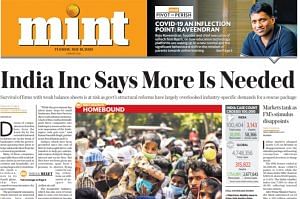 Mint echoes the sentiments of other newspapers today — it carries a picture of migrant workers awaiting trains with the caption “HOMEBOUND”.
Mint echoes the sentiments of other newspapers today — it carries a picture of migrant workers awaiting trains with the caption “HOMEBOUND”.
The first three paragraphs of the lead, ‘India Inc Says More Is Needed’, is the paper’s own analysis of the state of Indian companies, especially Covid-hit sectors like aviation and hospitality. It criticises the government’s rescue package as having only focused on “supply-side issues” instead of “industry-specific demands”. It remarks: “This has put the survival of …firms, which are bleeding cash with little or no revenue, and the jobs of thousands of people employed by them at risk.”
Talking of bleeding businesses, another report notes Swiggy’s plans to downsize. The online food delivery firm seeks to “lay off 1,100 employees across cities, just four days after rival Zomato axed over 500 staff members”, it reports.
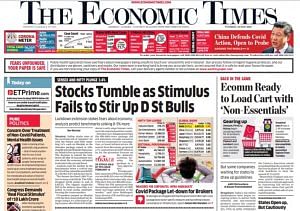 In more news on how the Modi government’s economic package was unimpressive, Economic Times leads with how Indian stocks tumbled Monday after the package “aimed at infusing life into the floundering economy”, had “failed to live up to expectations”. The Sensex and Nifty fell 3.4 per cent each and analysts expect “a further 8-9% fall in near term”, it adds.
In more news on how the Modi government’s economic package was unimpressive, Economic Times leads with how Indian stocks tumbled Monday after the package “aimed at infusing life into the floundering economy”, had “failed to live up to expectations”. The Sensex and Nifty fell 3.4 per cent each and analysts expect “a further 8-9% fall in near term”, it adds.
In some faint good news, e-commerce companies have started accepting both essential and non-essential items except in containment zones. While “Amazon, baby products retailer Firstcry and beauty portal Nykaa” restarted full-fledged operations Monday, Flipkart and eyewear portal Lenskart opted for a more “cautious approach by restricting full service to only those states that specifically permit online sale of nonessential goods”.

COMMENTS